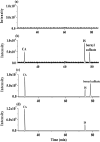Pharmacokinetic profile and metabolite identification of bornyl caffeate and caffeic acid in rats by high performance liquid chromatography coupled with mass spectrometry
- PMID: 35518073
- PMCID: PMC9060532
- DOI: 10.1039/c8ra07972b
Pharmacokinetic profile and metabolite identification of bornyl caffeate and caffeic acid in rats by high performance liquid chromatography coupled with mass spectrometry
Abstract
Bornyl caffeate was initially discovered as a bioactive compound in medicinal plants. Despite the promising pharmacological activities including anti-tumor and antibacterial activities, the pharmacokinetics of the compound remain open. This work developed a high performance liquid chromatography-tandem mass spectrometric method for the determination of bornyl caffeate and caffeic acid (major metabolite and a main unit of bornyl caffeate) in vivo. Successful application of the method included identification of its metabolites and investigation on the drug pharmacokinetics. A total of 30 compounds were identified as the metabolites of bornyl caffeate in rats. We attributed these metabolites to phase I metabolic routes of reduction, oxidation, hydrolysis and phase II metabolic reactions of glucuronidation, sulfation, O-methylation and glycine. Glucuronidation, sulfation, O-methylation and reduction were the main metabolic pathways of bornyl caffeate. The method presented a linear range of 1-4000 ng mL-1. The pharmacokinetic profile of bornyl caffeate was found to be a three compartment open model, while caffeic acid fitted to a two compartment open model when it was administered alone or served as the main metabolite of bornyl caffeate. The time to peak concentration (T max) and the maximum plasma concentration (C max) of bornyl caffeate were 0.53 h and 409.33 ng mL-1. Compared with original caffeic acid, the compound displayed an increased half-life of elimination (T 1/2β), area under the concentration time curve from 0 to t (AUC0-t ) and area under the concentration time curve from 0 to ∞ (AUC0-∞), a decreased half-life of absorption (T 1/2α) and an identical C max. Taking together, we concluded that bornyl caffeate is able to rapidly initiate therapeutic effect and last for a relatively long time in rats; metabolic pathways of O-methylation and reduction is key to interpret the mechanism and toxicity of bornyl caffeate.
This journal is © The Royal Society of Chemistry.
Conflict of interest statement
There are no conflicts to declare.
Figures





Similar articles
-
Biochemical mechanisms of bornyl caffeate induced cytotoxicity in rat pheochromocytoma PC12 cells.Chem Biol Interact. 2014 Aug 5;219:133-42. doi: 10.1016/j.cbi.2014.05.018. Epub 2014 Jun 5. Chem Biol Interact. 2014. PMID: 24907532
-
Bornyl caffeate induces apoptosis in human breast cancer MCF-7 cells via the ROS- and JNK-mediated pathways.Acta Pharmacol Sin. 2014 Jan;35(1):113-23. doi: 10.1038/aps.2013.162. Epub 2013 Dec 16. Acta Pharmacol Sin. 2014. PMID: 24335836 Free PMC article.
-
Pharmacokinetic, bioavailability, and metabolism studies of lusianthridin, a dihydrophenanthrene compound, in rats by liquid chromatography/electrospray ionization tandem mass spectrometry.J Pharm Biomed Anal. 2021 Feb 20;195:113836. doi: 10.1016/j.jpba.2020.113836. Epub 2020 Dec 9. J Pharm Biomed Anal. 2021. PMID: 33358433
-
Tolerability and pharmacokinetics of ranolazine following single and multiple sustained-release doses in Chinese healthy adult volunteers: a randomized, open-label, Latin square design, phase I study.Am J Cardiovasc Drugs. 2013 Feb;13(1):17-25. doi: 10.1007/s40256-013-0006-7. Am J Cardiovasc Drugs. 2013. PMID: 23355361 Clinical Trial.
-
Pharmacokinetics of single-dose and multiple-dose memantine in healthy chinese volunteers using an analytic method of liquid chromatography-tandem mass spectrometry.Clin Ther. 2008 Apr;30(4):641-53. doi: 10.1016/j.clinthera.2008.04.005. Clin Ther. 2008. PMID: 18498913 Clinical Trial.
Cited by
-
Discovery of quality markers of Meconopsis quintuplinervia based on an absorption-based metabolite approach and rapid quantification using polarity-switching UPLC-QQQ-MS/MS.Front Pharmacol. 2024 Dec 6;15:1474768. doi: 10.3389/fphar.2024.1474768. eCollection 2024. Front Pharmacol. 2024. PMID: 39712497 Free PMC article.
-
Screening Bioactive Compounds of Siraitia grosvenorii by Immobilized β2-Adrenergic Receptor Chromatography and Druggability Evaluation.Front Pharmacol. 2019 Aug 16;10:915. doi: 10.3389/fphar.2019.00915. eCollection 2019. Front Pharmacol. 2019. PMID: 31474867 Free PMC article.
-
Study on the Formation of Antihypertensive Twin Drugs by Caffeic Acid and Ferulic Acid with Telmisartan.Drug Des Devel Ther. 2020 Mar 5;14:977-992. doi: 10.2147/DDDT.S225705. eCollection 2020. Drug Des Devel Ther. 2020. PMID: 32184567 Free PMC article.
-
Analysis of the chemical constituents and their metabolites in Orthosiphon stamineus Benth. via UHPLC-Q exactive orbitrap-HRMS and AFADESI-MSI techniques.PLoS One. 2024 Jun 25;19(6):e0304852. doi: 10.1371/journal.pone.0304852. eCollection 2024. PLoS One. 2024. PMID: 38917120 Free PMC article.
-
Voltamperometric Sensors and Biosensors Based on Carbon Nanomaterials Used for Detecting Caffeic Acid-A Review.Int J Mol Sci. 2020 Dec 4;21(23):9275. doi: 10.3390/ijms21239275. Int J Mol Sci. 2020. PMID: 33291758 Free PMC article. Review.
References
-
- Rao C. Y. Desai D. Simi B. Kulkarni N. Aniin S. Redd B. S. Inhibitory effect of caffeic acid esters on azoxymethane-induced biochemical changes and aberrant crypt foci formation in rat colon. Cancer Res. 1993;53:4182–4188. - PubMed
-
- Wu J. Omene C. Karkoszka J. Bosland M. Eckard J. Klein C. B. Frenkel K. Caffeic acid phenethyl ester (CAPE), derived from a honeybee product propolis, exhibits a diversity of anti-tumor effects in pre-clinical models of human breast cancer. Cancer Lett. 2011;308:43–53. doi: 10.1016/j.canlet.2011.04.012. - DOI - PMC - PubMed
LinkOut - more resources
Full Text Sources

